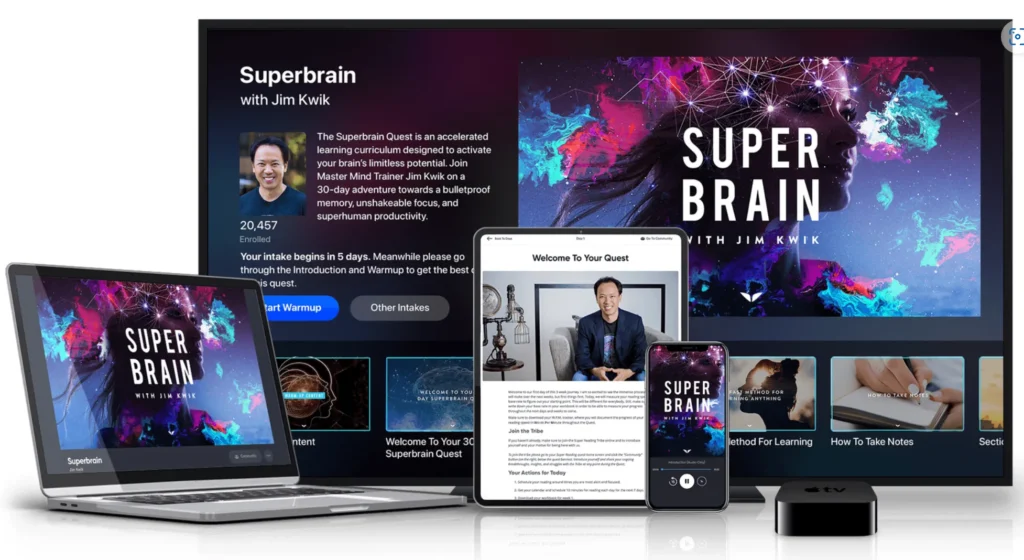Mindvalley’s Superbrain by Jim Kwik: Is It Worth Your Time and Money?
Hey there! If you’ve been scrolling through self-improvement courses online, chances are you’ve stumbled across Mindvalley Superbrain by Jim Kwik.
It’s one of those programs that promise to unlock your brain’s hidden potential—better memory, faster learning, sand harper focus. Sounds amazing, right?
But does it actually deliver, or is it just another overhyped course?
As someone who’s dug into the reviews, peeked at what people are saying across the web and analyzed the whole deal, I’m here to break it down for you in a way that’s easy to follow. Let’s dive in and see if Superbrain is the real deal or just a fancy sales pitch.
What Is Superbrain All About?

First off, let’s get the basics straight. Superbrain is a 30-day online course (or “Quest,” as Mindvalley calls it) led by Jim Kwik, a guy who’s built a big name for himself as a brain coach. The idea?
To help you supercharge your mind with practical tools for memory, focus, and learning speed. It’s hosted on Mindvalley, a platform known for personal growth courses that mix self-help with a touch of science and inspiration.
The course is broken into bite-sized daily lessons—think 15-20 minutes a day—designed to fit into your busy life. Jim promises that by the end, you’ll remember names like a pro, read faster, and tackle tasks with laser focus.
He’s worked with big shots like Elon Musk and Will Smith, so the guy’s got some cred. But the real question is: can he help regular folks like you and me turn our brains into supercomputers?
Who’s Jim Kwik, Anyway?

Before we get into the course, let’s talk about the man behind it. Jim Kwik’s story is pretty inspiring. As a kid, he suffered a traumatic brain injury that left him struggling with learning. He was the “boy with the broken brain,” as he puts it.
But instead of giving up, he turned it around—teaching himself how to learn better and faster. Now, he’s a global expert in memory improvement and speed reading, with a client list that reads like a Hollywood red carpet.
His personal journey adds a layer of authenticity to Superbrain. He’s not just some guru spouting theory—he’s lived it.
That said, a great story doesn’t automatically mean a great course. So, let’s see what Superbrain actually offers.
What You Get in Superbrain?

The course is structured over 30 days, with a few bonus videos thrown in. Each day, you watch a short video where Jim teaches a specific technique—like how to remember names, memorize lists, or speed-read without losing comprehension.
Then, you’re given a little task to practice what you’ve learned. It’s hands-on, which is a big plus if you’re someone who likes to do rather than just listen.
Here’s a quick rundown of what people say it covers, based on reviews from sites like Learnopoly, E-Student, and Hack Spirit:
- Memory Hacks: Jim teaches tricks like the “Memory Palace” (imagining a familiar place to store info) and acronyms to lock in details—like names, numbers, or even speeches.
- Speed Reading: You’ll learn how to zip through books faster while still understanding what’s on the page.
- Focus Boosters: Tips to cut through brain fog and stay on task, even when distractions are everywhere.
- Learning Smarter: Jim’s all about working with your brain’s natural strengths, not just cramming more info in.
There are also bonus Q&A sessions and a community (called the “Tribe”) where you can chat with other students. Oh, and if you’re wondering about cost, it’s tied to a Mindvalley membership—$499/year for access to all their courses, or $99/month if you just want to dip your toes in.
The Good Stuff: What People Love
Alright, let’s get to the juicy part—what’s working for people? After combing through reviews on Trustpilot, Reddit, and sites like Ideapod and GolemanEI, here’s what stands out:
- It’s Practical: Tons of users rave about how actionable the techniques are. For example, Kari from EatLearnWrite went from remembering two numbers at a time to six after the course. Small win, big impact. Others say they’ve nailed remembering names at parties or aced presentations without notes.
- Engaging Delivery: Jim’s a natural teacher. Reviewers—like one from E-Student—say he keeps you hooked, even in a video format. His energy and storytelling make the daily lessons fun, not a chore.
- Bite-Sized Lessons: The 15-20 minute chunks are a hit. People love that it’s not a time-suck—you can squeeze it into your morning coffee routine and still see progress.
- Real Results: A common thread is that the memory tricks stick. Two years after taking it, the E-Student reviewer still used Jim’s methods. That’s a sign it’s not just a quick fix—it builds habits.
On Mindvalley’s own site, over 3 million people have enrolled, and the reviews there are glowing. Students say it’s boosted their confidence at work, helped them study smarter, or even made daily life (like remembering grocery lists) smoother.
The Not-So-Great Stuff: Where It Falls Short
No course is perfect, and Superbrain has its critics. Here’s what some folks—especially from Reddit and Quora—point out:
- Repetitive Content: A few users, like one on Reddit (u/hustla17), argue that Jim’s techniques—like mnemonics—aren’t new. You can find similar stuff for free on YouTube or in books. If you’re already into memory hacks, this might feel like a pricey rehash.
- Not for Everyone: Professionals like scientists or PhDs might find it too basic, according to MyClassTracks. It’s aimed at everyday people, not niche experts needing advanced brain training.
- Time Commitment: While the daily lessons are short, you’ve got to stick with it for 30 days. Some reviewers—like on Hack Spirit—say it’s not binge-friendly, which can be a drag if you’re impatient.
- Cost Concerns: The price tag raises eyebrows. At $499 for a year of Mindvalley (or $449 standalone, per some sites), it’s not cheap. Critics say you’re paying for Jim’s name and slick production as much as the content.
There’s also a bit of skepticism about Mindvalley’s hype. Some Trustpilot reviews call out their flashy marketing—like claiming it’ll “transform your life overnight.” It’s not magic; it takes effort.
My Take: Does It Work?
So, does Superbrain live up to the buzz?
Based on what I’ve seen, it’s a solid yes for the right person—but it’s not a one-size-fits-all miracle. If you’re someone who forgets names five seconds after hearing them, struggles to focus, or wants to read faster without zoning out, this could be a game-changer.
The techniques are legit—rooted in proven methods like visualization and spaced repetition—and Jim’s teaching style makes them stick.
But if you’re expecting to become a genius overnight or already know your way around memory tricks, you might not get your money’s worth. It’s less about groundbreaking science and more about packaging practical tools in a fun, digestible way. The real magic happens when you use what you learn consistently.
Who Should Try It?
Here’s my two cents on who’d get the most out of Superbrain:
- Busy Professionals: If you’re juggling meetings and need to retain info fast, this could boost your edge.
- Students: Struggling with exams or focus? Jim’s hacks could make studying less of a slog.
- Lifelong Learners: Love self-improvement and want a sharper mind? This fits the bill.
- Forgetful Folks: Tired of blanking on names or where you parked your car? This is your jam.
If you’re a skeptic who hates daily commitments or already aces memory games, maybe skip it.
Alternatives to Consider
Not sold yet? There are other options out there. Jim’s own Super Reading course on Mindvalley dives deeper into speed reading. Platforms like Brilliant.org or Udemy’s brain training courses are cheaper and more flexible. Or, honestly, you could hit up YouTube—Jim’s got free videos there that cover some of the same ground.
The Verdict: Worth It or Not?
After digging through the web, here’s my final take: Mindvalley Superbrain is worth it if you’re ready to put in the work and want a structured, engaging way to level up your brain.
It’s not a scam—Jim delivers real tools that can make a difference, backed by his own inspiring story and years of experience. But it’s not cheap, and it’s not revolutionary if you’re already clued into memory techniques.
If you’re on the fence, try Jim’s free Superbrain masterclass on Mindvalley first. It’s an hour-long teaser that gives you a taste of his style and a few tricks to test out. If it clicks for you, the full course could be a smart investment—especially with Mindvalley’s 15-day refund policy.
So, what do you think? Ready to unleash your inner superbrain, or are you holding out for something else? Either way, your brain’s got potential—Jim’s just one guy offering a roadmap to tap into it.
© 2025 Mindvalley, Inc.